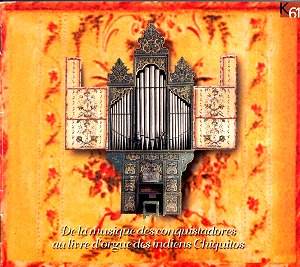






De la Musique des Conquistadores au Livre d’orgue des Indiens Chiquitos
TRIPLE CD
VOLUME 1: Musiques pour orgue du temps des conquistadores: Organ music by: 1.CREQUILLON: Canción "Pour une plaisir", 2. Alonso MUDARRA: Gallarda (para vihuela o tecla) , 3. Francisco F. PALERO: Romance: Paseábase el rey moro, 4. Anonyme: Canción "Réveillez-vous…", 5. Francisco Correa DE ARAUXO: Tiento de medio registro de tiple , 6 à 8: Antonio DE CABEZÓN: -Duo para principiantes,- Pavana con su glosa,- Tiento de quarto tono,9. Hernando DE CABEZÓN: Dulce memoriae (en memoria de su padre), 10. Julius DE MODENA: Tiento de quarto tono, 11. Francisco Correa DE ARAUXO: Tiento de medio registro de dos tiples, 12 à 15. Tomas de SANTA MARIA: 4 Fantasias ,16 à 18. Juan BERMUDO:- Conditor alme siderum, - Ave maris stella, - Vexilla regis prodeunt (a5), 19 et 20. Francisco Correa DE ARAUXO: -Tiento de medio registro de tiple, - Tiento pequeño y facil de cuarto tono, 21 et 22. Sebastian aguilera DE HEREDIA:- Pange Lingua español, - Tiento de falsas de cuarto tono, 23. Andres DE SOLA: Tiento de primer tono de mano derecha, 24. Pablo BRUNA: Tiento de falsas- 2o tono, 25. Diego DE TORRIJOS: Tiento lleno. [54’32]
Francis Chapelet (France), Organist
Historic organ by: Frère Pedro de Matos, 1791-92, restored by Pascal Quoirin, 1997, Convent of Santa Clara de Sucre, Sucre, Bolivia.
Recorded:1998, Convent of Santa Clara de Sucre, Sucre, Bolivia.
VOLUME 2: Les vice-royaumes du Pérou et de Nouvelle-Espagne: Organ works by: 1. Estacio LACERNA: Tiento de sexto tono, 2 à 13. Lucas RUIZ RIBAYAZ: -Chaconas,-Pabanas,-Xacaras,-Folias,-Achas,-Buelta del Hacha,-Zarabandas,-Rugero,-Bacas,-Villano,-Galeria del amor,-Paradetas,14. Maestro Cabrera DEL PERÚ: Fantasia "scala celite", 15. Juan Pérez BOCANEGRA: Hanacpachap cussicuinin, 16. Antonio CARRIERA: Con qué la lavaré, 17 à19. Anonyme espagnol del Convento de Santa Eulalia (c.1590):- Pavana,-Romance,-Tonos, 20 à 23. Juan BERMUDO: -Pange Lingua, -Conditor alme siderum,- Ave maris stella (Glose de l’interpréte),- Veni creator spiritus, 24. San Juan DE LIMA: Diferencias, 25. Anonyme de San Antonio abad: Caraviñas sao, 26. Manuel J. DE QUIROS: Luzid fragante rosa, 27. Anonyme de San Antonio abad: Un juguetico de fuego, 28. Sebastián DURON: Claro arrebol, 29. Padre A.SOLER: Sonatas de clarines. [52’59]
Cristina Garcia Banegas (Uruguay), Organist
Historic organ: by Frère Pedro de Matos, 1791-92, restored by Pascal Quoirin, 1997,Convent of Santa Clara de Sucre, Sucre, Bolivia.
Recorded:1998, Convent of Santa Clara de Sucre, Sucre, Bolivia.
VOLUME 3: Sones mo organo-Les Livres pour clavier de San Rafael de Chiquitos-Organ works by Martin SCHMID (1694-1772): Tono I:1.Preludio, 2.Folías, 3.Dos versos, 4.(Alemanda), 5. (Corrente), Tono II: 6. Cuatro versos, 7. Zipoli: Retirada del emperador, 8. (Giga), 9. Francesa, Tono III: 10. Cuatro versos, 11. Tocada Allegro-Grave-Allegro, 12. Africa, 13. (Sonata), 14. (Giga), 15. (Aria), Tono IV: 16. (Aria), Tono V: 17.Al Nacimiento del Archedug (Allegro)-(Siciliana)-(Presto), 18. (Pastoral I-II), 19. Sones mo organo, 20.Verso, 21. Del Principe, 22. Marcha alemana, 23. (Sonata), 24. (Sonata), Tono VI: 25. Sonata I Adagio-(Allegro)-Adagio-(Presto), 26. Reina de Ungria, Tono VII: 27. Son los sones de Organo, 28. Hazme Reir, 29. Marcosi:Sal si puedes, 30. Sinfonia, Tono VIII: 31. Fugado, 32. Jesús, 33. (Sonata), 34. (Sonata), 35. (Sonata), 36. (Sonata). [75’49]
Historic organ: by Frère Pedro de Matos, 1791-92, restored by Pascal Quoirin, 1997, Convent of Santa Clara de Sucre, Sucre, Bolivia.
Recorded:1998, Convent of Santa Clara de Sucre, Sucre, Bolivia.
BUY NOW
AmazonUK AmazonUS Lower Midprice